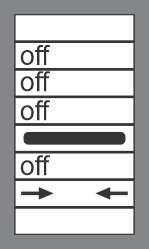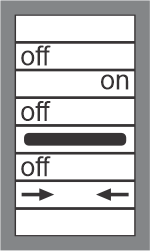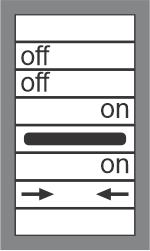Warning
Settings may only be changed by a qualified engineer.
Carefully read the instructions before changes are made.
Batteries should be placed in a dry and well-ventilated area during charging.
On delivery, the Multi is set to standard factory values. In general, these settings are suitable for single-unit operation.
Warning
Warning: The standard charging voltage might not be appropriate for your batteries. Consult the manufacturer's documentation or your battery supplier for guidance.
Setting | Default value |
|---|---|
Inverter frequency | 60 Hz |
Input frequency range | 55 - 65 Hz |
Input voltage range | 94 - 143 VAC |
Inverter voltage | 120 VAC |
Stand-alone / parallel / 3-phase | stand-alone |
Search mode | off |
Ground relay | on |
Charger on/off | on |
Battery charge algorithm | four-stage adaptive withBatterySafe mode |
Charge current | 100 % of the maximum charge current |
Battery type | Victron Gel Deep Discharge (also suitable for Victron AGM Deep Discharge) |
Automatic equalisation charging | off |
Absorption voltage | 14.4V |
Absorption time | up to 8 hours (depending on bulk time) |
Float voltage | 13.8V |
Storage voltage | 13.2V (not adjustable) |
Repeated absorption time | 1 hour |
Absorption repeat interval | 7 days |
Bulk protection | off |
AC input current limit | 12A (= adjustable current limit for PowerControl andPowerAssist functions) |
UPS feature on | on |
Dynamic current limiter off | off |
Weak AC | off |
Boost factor | 2 |
Programmable relay | alarm function |
Settings that are not self-explanatory are described briefly below.
For further information on these settings, refer to the help files in the software configuration programs as indicated in the next Configuration by computer chapter.
Inverter frequency
Output frequency if no AC is present at the input: 60Hz
Input frequency range
Input frequency range accepted by the Multi. The Multi synchronises within this range with the AC input frequency. The output frequency is then equal to the input frequency.
Adjustability: 55 – 65 Hz.
Inverter voltage
Output voltage of the Multi in battery operation.
Adjustability: 95-128V.
Input voltage range
Voltage range accepted by the Multi. The Multi synchronises within this range with the AC input voltage. The output voltage is then equal to the input voltage.
Adjustability:
Lower limit: 94 – 120V
Upper limit: 120 – 143 V
Stand-alone / parallel operation / 2-3 phase setting
Using several devices, it is possible to:
Increase total inverter power (several devices in parallel).
Ccreate a split-phase system.
Ccreate a 3-phase system.
The standard product settings are for standalone operation. For parallel, or three phase operation see the Parallel connection and Three-phase connection chapters.
Search mode
If search mode is “on”, the power consumption in no-load operation is decreased by approx. 70 %. In this mode the Multi, when operating in inverter mode, is switched off in case of no load or very low load, and switches on every two seconds for a short period. If the output current exceeds a set level, the inverter will continue to operate. If not, the inverter will shut down again.
Search Mode can be set with a DIP switch.
Search Mode “shut down” and “remain on” load levels can be set with VEConfigure. The standard settings are:
Shut down: 30 Watt (linear load)
Turn on: 60 Watt (linear load)
AES (Automatic Economy Switch)
Instead of the search mode, the AES mode can also be chosen (with help of VEConfigure only).
If this setting is turned “on”, the power consumption in no-load operation and with low loads is decreased by approx. 20 %, by slightly “narrowing” the sinusoidal voltage
Ground relay
With this relay the neutral conductor of the AC output is grounded to the chassis when the back-feed safety relay is open (See chapter Internal wiring diagram, item H). This ensures the correct operation of earth leakage circuit breakers in the output.
If a non-grounded output is required during inverter operation, this function must be turned off (use VE-Configure or teh VictronConnect app).
Charge curve
The standard setting is “Four-stage adaptive with BatterySafe mode”. See chapter Battery charger for a description. This is the recommended charge curve. See the help files in the software configuration programs for other features.
Battery type
The standard setting is the most suitable for Victron Gel Deep Discharge, Gel Exide A200, and tubular plate stationary batteries (OPzS). This setting can also be used for many other batteries: e.g. Victron AGM Deep Discharge and other AGM batteries, and many types of flat-plate flooded batteries. Four charging voltages can be set with DIP switches.
Automatic equalisation charging
This setting is intended for tubular plate traction batteries. During absorption, the voltage limit increases to 2.83 V/cell. Once the charge current has tapered down to less than 10 % of the set maximum current.
Absorption time
The absortion time depends on the bulk time (adaptive charge curve), so that the battery is optimally charged. If the “fixed” charging characteristic is selected, the absorption time is fixed. For most batteries, a maximum absorption time of eight hours is suitable. If an extra high absorption voltage is selected for rapid charging (only possible for open, flooded batteries!), four hours is preferable. With DIP switches, a time of eight or four hours can be set. For the adaptive charge curve, this determines the maximum absorption time.
Storage voltage, Repeated Absorption Time, Absorption Repeat Interval
See the Battery charger chapter.
Bulk Protection
Default setting: off. When this setting is “on”, the bulk charging time is limited to 10 hours. A longer charging time could indicate a system error (e.g. a battery cell short-circuit).
AC input current limit
These are the current limit settings at which PowerControl and PowerAssist come into operation. The factory setting is 12A.
UPS feature
If this setting is “on” and AC on the input fails, the Multi switches to inverter operation practically without interruption. The Multi can therefore be used as an Uninterruptible Power Supply (UPS) for sensitive equipment such as computers or communication systems. The output voltage of some small generator sets is too unstable and distorted for using this setting* – the Multi would continually switch to inverter operation. For this reason, the setting can be turned off. The Multi will then respond less quickly to AC input voltage deviations. The switchover time to inverter operation is consequently slightly longer, but most equipment (most computers, clocks or household equipment) is not adversely impacted.
Recommendation: Turn the UPS feature off if the Multi fails to synchronise, or continually switches back to inverter operation.
*In general, the UPS setting can be left “on” if the Multi is connected to a generator with a “synchronous AVR regulated alternator”.
The UPS mode may have to be set to “off” if the Multi is connected to a generator with a “synchronous capacitor regulated alternator” or an asynchronous alternator.
Dynamic current limiter
Intended for generators, the AC voltage is generated by means of a static inverter (so-called “inverter” generator). In these generators, rpm is down-controlled if the load is low: this reduces noise, fuel consumption and pollution. A disadvantage is that the output voltage will drop severely or even completely fail in the event of a sudden load increase. More load can only be supplied after the engine is up to speed.
If this setting is “on”, the Multi will reduce the charge current until the set current limit is reached. This allows the generator engine to get up to speed. This setting is also often used for “classic” generators that respond slowly to sudden load variation.
Weak AC
Strong distortion of the input voltage can result in the charger hardly operating or not operating at all. If Weak AC is set, the charger will also accept a strongly distorted voltage, at the cost of greater distortion of the input current.
Recommendation: Turn Weak AC on if the charger is hardly charging or not charging at all (which is quite rare!). Also, turn on the dynamic current limiter simultaneously and reduce the maximum charging current to prevent overloading the generator if necessary.
BoostFactor
Change this setting only after consulting with Victron Energy or with an engineer trained by Victron Energy!
Programmable relay
By default, the programmable relay is set as an alarm relay, i.e. the relay will de-energise in the event of an alarm or a pre-alarm (inverter almost too hot, ripple on the input almost too high, battery voltage almost too low). With VEConfigure software or the VictronConenct app, the relay can also be programmed for other purposes, for example, to provide a generator starting signal.
All settings can be changed by means of a phone, tablet or computer.
The following is required:
The VictronConnect app or the VEConfigure3 software package. Both can be downloaded free of charge from the downloads section on www.victronenergy.com.
An Interface MK3-USB and a RJ45 UTP cable.
Refer to the VictronConnect configuration guide for VE.Bus products document for further instructions and further explanation of the various settings.
Note that some settings can also be changed with DIP switches (see the next Configuration by DIP switches chapter).
Some settings can be changed with DIP switches.
Procedure:
Turn the Multi on, preferably without load and without AC voltage on the input. The Multi will then operate in inverter mode.
Set the DIP switches as required.
Store the settings by moving DIP switch 6 to “on” and back to “off”.
DIP switch 1
Default setting: to operate the product with the “On/Off/Charger Only” switch ds 1: “off” When combined with the Digital Multi Control panel, a VE.Bus Smart dongle, CCGX, Venus GX or alike, DIP switch 1 should also be in the “off” position. Setting for operation with a 3-position remote switch: ds 1: “on” The 3-position switch must be wired to terminal H, see appendix A.
Use only one type of remote control: either a switch or a Digital Multi Control panel.
DIP switch 2 and 3
These DIP switches can be used to set:
Battery charge voltage and Absorption time
Search mode
(For more system settings, use VEConfigure or the VictronConnect app)
DS 2 - DS 3 | Absorption voltage (V) | Float voltage (V) | Storage Voltage (V) | Absorption Time (hours) | Suitable battery types |
|---|---|---|---|---|---|
DS 2=off DS 3=off (default) | 14.4 | 13.8 | 13.2 | 8 | Gel Victron deep discharge Gel Exide A200 AGM Victron deep discharge |
DS 2=on DS 3=off | 14.1 | 13.8 | 13.2 | 8 | Gel Victron long life (OPzV) Long Life (OPzV) Gel Exide A600 (OPzV) Gel MK battery Li-ion (LiFePO4) |
DS 2=off DS 3=on | 14.7 | 13.8 | 13.2 | 5 | AGM Victron deep discharge Tubular plate or OPzS batteries in semi-float mode AGM spiral cell |
Dip switch 4
Not used
Dip switch 5
Search Mode off = off on = on
Store the settings by moving DIP switch 6 to “on” and back to “off”.
Example 1 (factory setting) | Example 2 | Example 3 | ||||||
|---|---|---|---|---|---|---|---|---|
|
|
| ||||||
1: 3-position switch connected 2,3: GEL 14.4V 4: any position 5: Search mode off 6: Store setting: off→ on→ off | 1: 3-position switch connected 2,3: GEL long life 14.4V (lithium) 4: any position 5: Search mode off 6: Store setting: off→ on→ off | 1: 3-position switch connected 2,3: Tubular plate 15V 4: any position 5: Search mode on 6: Store setting: off→ on→ off |
Example 1 is the factory setting (since factory settings are entered by computer, all DIP switches of a new product are set to “off”).
Store the settings by changing switch DS-6 from off to on, and then back to off. The LEDs “charger” and “alarm” will flash to indicate acceptance of the settings.


